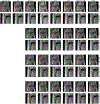Joint Frequency and Image Space Learning for MRI Reconstruction and Analysis
- PMID: 36349348
- PMCID: PMC9639401
Joint Frequency and Image Space Learning for MRI Reconstruction and Analysis
Abstract
We propose neural network layers that explicitly combine frequency and image feature representations and show that they can be used as a versatile building block for reconstruction from frequency space data. Our work is motivated by the challenges arising in MRI acquisition where the signal is a corrupted Fourier transform of the desired image. The proposed joint learning schemes enable both correction of artifacts native to the frequency space and manipulation of image space representations to reconstruct coherent image structures at every layer of the network. This is in contrast to most current deep learning approaches for image reconstruction that treat frequency and image space features separately and often operate exclusively in one of the two spaces. We demonstrate the advantages of joint convolutional learning for a variety of tasks, including motion correction, denoising, reconstruction from undersampled acquisitions, and combined undersampling and motion correction on simulated and real world multicoil MRI data. The joint models produce consistently high quality output images across all tasks and datasets. When integrated into a state of the art unrolled optimization network with physics-inspired data consistency constraints for undersampled reconstruction, the proposed architectures significantly improve the optimization landscape, which yields an order of magnitude reduction of training time. This result suggests that joint representations are particularly well suited for MRI signals in deep learning networks. Our code and pretrained models are publicly available at https://github.com/nalinimsingh/interlacer.
Conflict of interest statement
Conflicts of Interest We declare we don’t have conflicts of interest.
Figures












References
-
- Anand C Shyam and Sahambi Jyotinder S. Wavelet domain non-linear filtering for MRI denoising. Magnetic Resonance Imaging, 28(6):842–861, 2010. - PubMed
-
- Andre Jalal B, Bresnahan Brian W, Mossa-Basha Mahmud, Hoff Michael N, Smith C Patrick, Anzai Yoshimi, and Cohen Wendy A. Toward quantifying the prevalence, severity, and cost associated with patient motion during clinical MR examinations. Journal of the American College of Radiology, 12(7):689–695, 2015. - PubMed
-
- Bahadir Cagla D, Wang Alan Q, Dalca Adrian V, and Sabuncu Mert R. Deep-learning-based optimization of the under-sampling pattern in MRI. IEEE Transactions on Computational Imaging, 6:1139–1152, 2020.
Grants and funding
LinkOut - more resources
Full Text Sources
